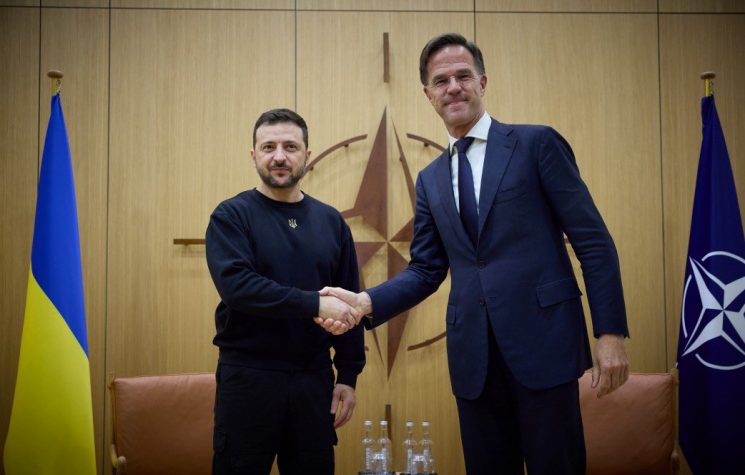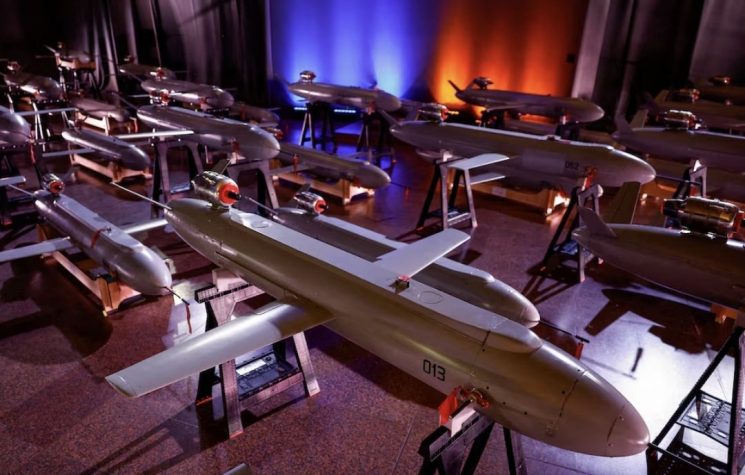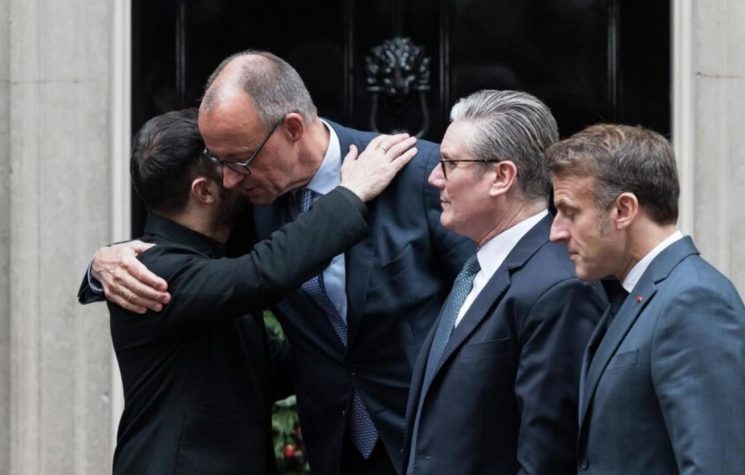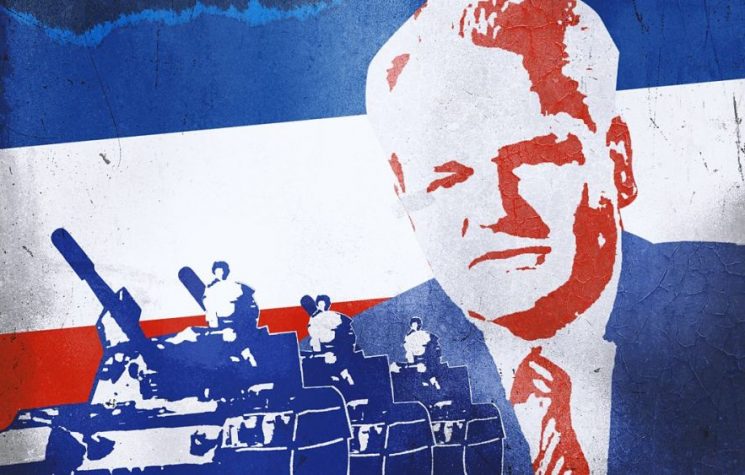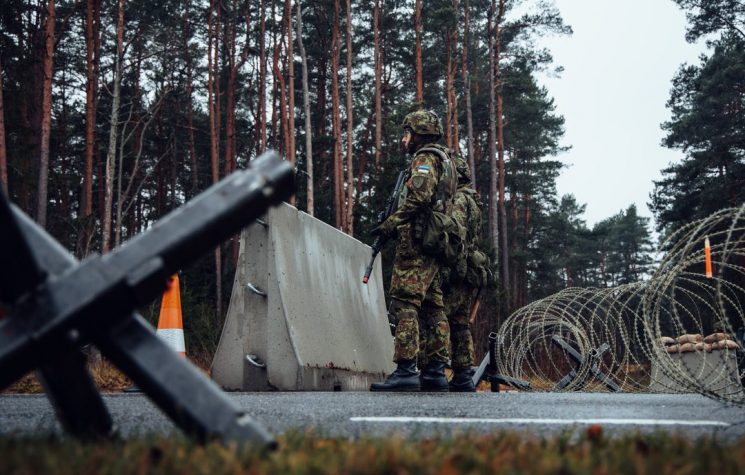We can only hope that President Biden will ignore the war fanatics and agree that negotiation is preferable to confrontation.
One of the recent political absurdities in Europe was a stage-managed photo sequence of Britain’s foreign minister Liz Truss posing boldly but comfortably with her head and shoulders poking out of the turret of a British army tank. The pathetic charade took place in Estonia, close to Russia, when she visited British troops deployed there as part of the U.S.-Nato buildup along Russia’s western frontier. She was on her way to attend a meeting of foreign ministers of the U.S.-Nato military alliance held on November 30 in Riga, the capital of Latvia, some 300 kilometres from Russia.
According to Nato, this is where it “has enhanced its forward presence in the eastern part of the Alliance, with four multinational battalion-size battlegroups in Estonia, Latvia, Lithuania and Poland, on a rotational basis.” The meeting of foreign ministers was chaired by publicity-hungry Secretary General of the Nato alliance, Jens Stoltenberg, who issued the usual challenge to Russia that “we stand together to defend and protect all Allies” — meaning, specifically, Ukraine, concerning which the U.S.-Nato military alliance will “maintain our political and practical support for our partner.” This includes confrontation in the air, under Nato orders whereby “allies take turns deploying to air bases at Šiauliai, Lithuania and Ämari, Estonia, on a four-month rotational basis, ready to be launched by NATO’s Combined Air Operations Centre Uedem, Germany if required.”
It is obvious to most people who desire peace that Russia has no intention of invading Ukraine, for a myriad of reasons, some of which are noted below. But if the western military grouping does manage to achieve its objective of confronting Russia to the point that Moscow has to take military action, then there’s one thing absolutely certain, and that is that Ms Liz Truss and Mr Jens Stoltenberg and the rest of the warmongers will be nowhere near a tank or any other piece of military equipment. In the event of conflict they will all be safe, sound and snug in their bomb-proof bunkers while soldiers and sailors and aircrew hazard their lives in the war that the U.S.-Nato military alliance eventually managed to provoke.
The tank antics of Ms Truss were intended to increase her domestic popularity, because she has significant political ambition and would stoop to any depths (and rise to any tank turret) if she imagined it might improve her standing. Her Tweet about the fandango read “Proud meeting [GB] NATO troops in Estonia at the frontier of freedom. Britain stands with our @NATO allies to defend liberty and democracy and counter malign threats.”
She then issued a malign threat against Russia.
Most English newspapers were supportive of Ms Truss, with the Daily Telegraph headlining that “Liz Truss shows Vladimir Putin she’s got the mettle of the Iron Lady”, giving prominence to comparing the foreign secretary with Prime Minister Margaret Thatcher who performed a similar public relations stunt in a tank turret in 1986. The paper announced that the recent silly frolic “was a photo opportunity designed to send the message to Vladimir Putin that Britain is serious about protecting Ukraine from aggression on its eastern border.”
The Daily Telegraph used to be a well-regarded commentator on international affairs — “the good old DT” — but if its editors believe that a photograph of foreign minister Truss in a British army tank turret will convince the President of Russia that Britain is prepared to go to war, then it must be agreed with regret that the DT, like the British government, has lost the plot.
Secretary General Stoltenberg is sending signals that he too is primed to increase tension to the point of bringing war with Russia alarmingly closer. On November 19 he gave a speech in Berlin which was aimed at convincing the new German government that it should continue the stationing of U.S. nuclear weapons in Germany. As it happened he was successful, and on November 24 Reuters reported that “Germany will remain part of NATO’s nuclear sharing agreement under its new government, according to a coalition deal agreed on Wednesday, a move that will prevent a rift in the Western military alliance at a time of rising tensions with Russia. Germany does not possess nuclear weapons, but hosts U.S. nuclear bombs that German Tornado fighter jets are meant to carry to target during a conflict.”
It had been hoped that some members of Germany’s coalition government would stick by their moral principles and not their political principals regarding nuclear weapons, but the tank disease struck them and they accepted the direction of Stoltenberg’s Berlin speech in which he declared that “So, of course, Germany can, of course, decide whether there will be nuclear weapons in your country, but the alternative is that we easily end up with nuclear weapons in other countries in Europe, also to the east of Germany.”
The leader of the anti-Russia military alliance is prepared for redeployment of U.S. nuclear weapons further east, and thus closer to Russia’s borders. He does not say how “easily” this will be effected when the orders are given, but the fact that he was confident enough to state in public that U.S.-Nato is prepared to position nuclear weapons “to the east of Germany” means that there has been planning for such relocation. So far as can be determined there has been no reaction from European Nato countries, and comment from the White House has been confined to complaining on December 3 about such things as “our serious concerns about the bellicose rhetoric, about the military buildup that we’re seeing on the border of Ukraine.”
The reprimand about “bellicose rhetoric” coincided with the public statement by U.S. defence secretary Lloyd Austin (on the Board of military industrialist Raytheon Technologies until last year) to the Polish minister of defence that they must examine more “ways to enhance deterrence along NATO’s Eastern Flank.”
Reaction in Moscow was firm, with Associated Press reporting that Mr Putin looked forward to dialogue with Mr Biden in which he would seek “reliable and long-term security guarantees,” stating that “in a dialogue with the United States and its allies, we will insist on working out specific agreements that would exclude any further NATO moves eastward and the deployment of weapons systems that threaten us in close vicinity to Russian territory.”
But it is unlikely that Washington will agree to any action that would reduce tension, because confrontation is the name of its game. The western military alliance is convinced — or says it is convinced — that Russia is going to invade Ukraine, and takes no account of reality, because it would, to put it bluntly, be economic suicide for Russia to do anything of the sort.
Make no mistake : if Russia wanted to invade Ukraine it could do so in a heartbeat and, as determined by several analyses conducted in western military academies, but never made public, in 2014 it could have occupied the country in about four weeks. But there is no point in Russia doing anything of the sort, because it would create an enormous internal security problem for absolutely no reason. Further, if it takes military action it would mean the end of the multi-billion dollar Nord Stream 2 pipeline on which so much depends in Europe and Russia. (It is not a coincidence that this is one of the main aims of Washington’s legislators, in order to make it necessary for Europe to purchase natural gas from the U.S.)
As recorded by the European Commission, “The EU is Russia’s biggest trade partner, accounting for 37.3% of the country’s total trade in goods with the world in 2020. 36.5% of Russia’s imports came from the EU and 37.9% of its exports went to the EU . . . The EU is the largest investor in Russia. In 2019, the EU’s outward foreign direct investment (FDI) stock in Russia amounted to €311.4 billion, Russia’s FDI stock in the EU was estimated at €136 billion.”
If Russia went to war against Ukraine, this mutually beneficial state of affairs would dissolve. Do these people in Washington, London and Brussels really believe that Russia wants to inflict such damage on its own economy?
But the pressure, the rhetoric, the Nato “forward presence” are being ramped up by such officials as Britain’s foreign minister whose silly pantomime in a tank turret characterised the U.S.-Nato approach to international affairs. We can but hope that President Biden will ignore the war fanatics and agree that negotiation is preferable to confrontation. If he appears in a tank, we’ll get the message.













